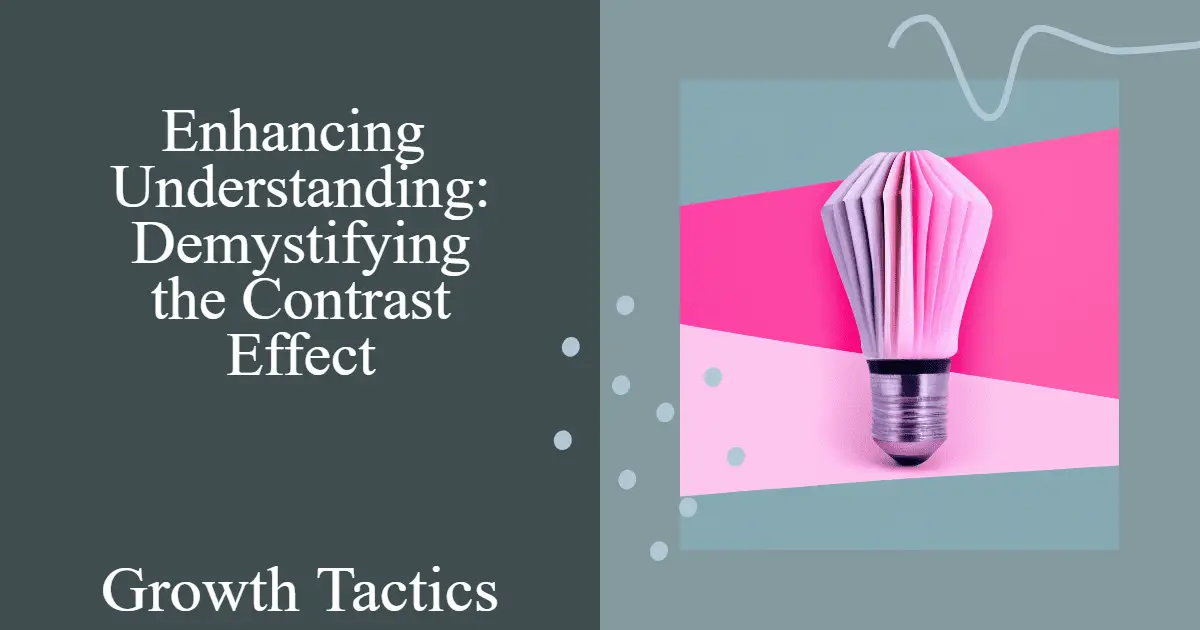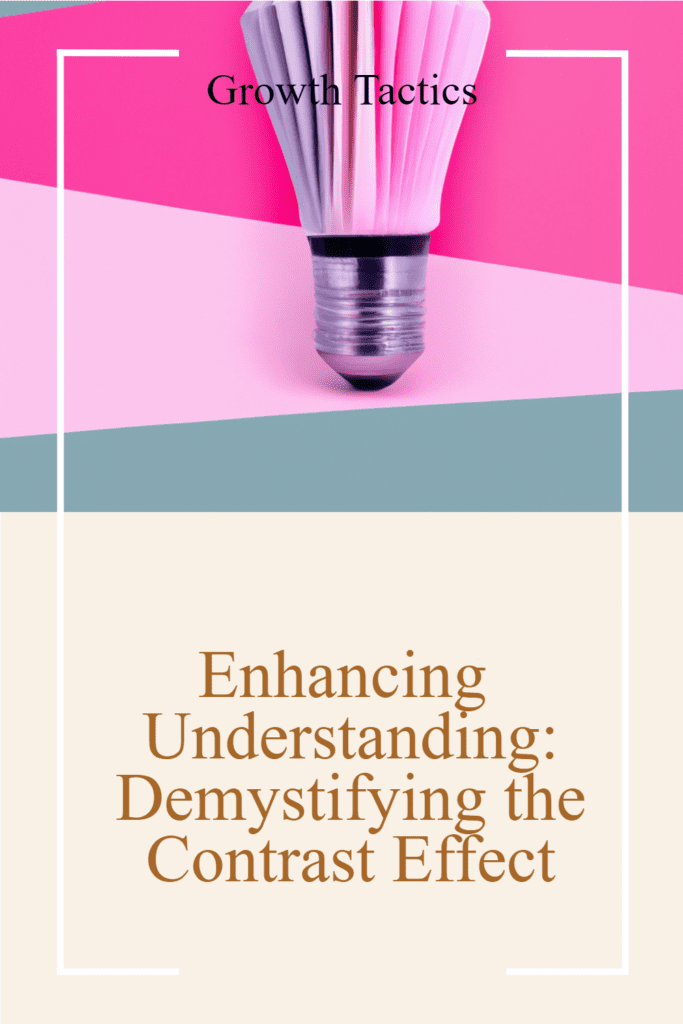Let’s explore the often-misunderstood concept of the ‘contrast effect’, its implications, and how it affects our daily perceptions. You’ll understand not just the basics, but the wide-ranging applications of this effect, especially in recruitment and decision-making processes. We’ll also explore ways to address, harness, and mitigate this behavior.
In today’s world where every decision counts, a comprehensive understanding of the contrast effect is more than knowledge, it’s an essential ingredient for better decision-making.
Definition of the Contrast Effect
The contrast effect refers to how our perception and evaluation of something can shift when presented with something else, thereby enhancing the differences. For instance, a seemingly expensive car might feel reasonably priced when placed next to a more high-end model.
Examples of The Contrast Effect
In order to deepen our understanding of the contrast effect, let’s consider a number of real-world examples that you may find relatable, articulate, and can effectively demonstrate this concept.
Example 1: Job Interviews and Recruitment
As previously mentioned, the recruitment process is a prime setting for the contrast effect. Imagine a hiring manager, who we’ll denote as the interviewer, conducting consecutive interviews of different candidates for a job position.
Suppose the first candidate interviewed performs exceptionally well, impressing the hiring manager with their qualifications, skills, and charisma. This candidate becomes a marker and sets a high bar for the following interviews. Now, even if the succeeding candidates are suitable for the position unless they surpass the performance of the first interviewee, they are likely to be evaluated less favorably due to the contrast effect.
Example 2: Consumer Behavior and Pricing Strategies
In marketing and consumer behavior, pricing strategies often take advantage of the contrast effect to manipulate consumer perception of value. For instance, consider a customer shopping for a television. Retail stores often arrange products from least to most expensive, or they strategically place a very expensive model next to a moderately priced one.
When the customer views the moderately priced television after observing the high-end model, thanks to the contrast effect, the less expensive item can appear more enticing due to its reasonable pricing against a high-value proposition.
Example 3: Visual Perception and Art
The contrast effect isn’t limited to decision-making or behavior; it’s a fundamental facet of vision and perception. This is vividly present in the realm of visual arts and photography. Consider a grayscale image with a single grey square surrounded by a darker shade. Due to the contrast effect, the grey square appears lighter than it is. However, when the same grey square is surrounded by a lighter background, it appears darker. This is a classic manifestation of simultaneous contrast illustrating how our perception of something can shift based on its surrounding context.
Example 4: Human Attractiveness and Social Comparison
Human perception of attractiveness is also influenced by the contrast effect. If a person is seen in the company of others considered less attractive, that person may seem more attractive than if seen alone or in the company of others considered more attractive. This social comparison effect has been demonstrated in numerous scientific studies and underscores how the contrast effect can unconsciously impact our judgment and preferences.
Together, these examples highlight the pervasive influence of the contrast effect across various facets of life and society. By understanding these examples, we can better recognize when this effect might be at play, helping us make more informed and unbiased decisions.
The Negative Contrast Effect: An In-Depth Analysis
As part of our exploration into the intricacies of the contrast effect, we turn our focus to a specific aspect called the negative contrast effect. This section provides an analytical and educational overview of the subject designed to equip curious learners with the knowledge and understanding of how this perceptual bias might manifest in our daily lives.
Understanding the Negative Contrast Effect
The negative contrast effect arises when an object or individual is evaluated less favorably due to the presence of a superior alternative. In other words, it occurs when the perception of something becomes negatively distorted as a result of comparing it with something perceived to be more attractive or desirable. Essentially, the negative contrast effect showcases the potential of the contrast effect to diminish the attractiveness or appeal of the target being evaluated based on context.
Examples to Illustrate the Negative Contrast Effect
To further clarify the concept, let us examine a few pragmatic examples that provide insight into the real-world consequences of the negative contrast effect.
Example 1: Shopping for Clothes
Imagine a shopper looking for a new outfit at a clothing store. They may find a dress they like and decide to try it on. In the fitting room, they discover another, seemingly more fashionable, dress hung up by the previous customer. Upon trying on the first dress, the shopper might now view it unfavorably, as it pales in comparison to the more stylish option that they didn’t initially consider. As a result, their perception of the original dress becomes negatively skewed due to the negative contrast effect.
Example 2: The Hiring Process
The negative contrast effect can also manifest in the hiring process. If a recruiter interviews a candidate with exceptional skills but ultimately deems them overqualified, they may turn to other, more suitable candidates. However, even the more suitable candidates might now appear less qualified in comparison to the overqualified candidate. Consequently, the recruiter’s perception of the subsequent candidates might become negatively influenced, even though their qualifications are appropriate for the job.
How to Avoid the Contrast Effect: Ensuring Objective Evaluations
Let’s explore practical strategies you can employ to minimize the impact of the contrast effect, consciously engage in fair evaluations, and make decisions based on objective standards.
Strategy 1: Develop Clear Evaluation Criteria
The first step to counter the contrast effect is to establish clear, measurable criteria for evaluating items or individuals in comparison. For example, during a recruitment process, base your evaluations on explicit criteria such as technical skills, work experience, cultural fit, interpersonal skills, and other relevant factors. When assessing products, pinpoint key features, prices, warranties, customer reviews, and other tangible criteria.
These predetermined criteria will guide evaluations towards individual merits rather than comparison, leveling off contrast-induced bias.
Strategy 2: Independent Evaluations
When feasible, conduct independent evaluations of objects or individuals to avoid direct comparisons. By assessing each entity independently, the perception of subsequent ones remains unaffected by prior evaluations. Independent evaluations aid in anchoring assessments on specific attributes rather than relative qualities.
Strategy 3: Controlled Exposure to Stimulus
In situations where contrasts are challenging to avoid try to control exposure to contrasting stimuli. For instance, if you’re attempting to gauge the effectiveness of a black-and-white design, present this in isolation without preceding multicolor stimuli. Controlling the stimulus exposure can minimize the influence of the contrast effect on perception.
Strategy 4: Conscious Awareness and Training
Awareness of perceptual biases like the contrast effect is crucial for avoiding their pitfall. With knowledge of its existence and potential influence on your judgment, you can intentionally check for its effect in your evaluations. Repeated practice and training can further enhance this conscious awareness, leading to improved decision-making over time.
Strategy 5: Reflection and Review of Decisions
Lastly, take time to reflect and review your decisions or evaluations. Ask yourself whether the contrast effect may have influenced your perceptions. If you suspect it has, reconsider your decision using the explicit criteria you established initially. Regular reflection on decisions can further hone awareness and ability to avert biases.
How to Use Contrast Effectively: Enhancing Communication and Decision-Making
While awareness of the contrast effect can help us avoid its pitfalls in decision-making, there are instances where using it intentionally can enhance communication, emphasize key points, or encourage specific choices. By understanding how to wield the contrast effect effectively, we can leverage its power in a multitude of situations. This article will provide strategies and practical examples on how to harness the contrast effect’s potential while maintaining transparency and clear communication.
Strategy 1: Emphasizing Important Information
The contrast effect can be employed to direct an audience’s attention to relevant or essential points. To do this, highlight critical information or arguments by presenting contrasting information. For example, outlining positive developments in the context of previous challenges can accentuate progress and improvement. Similarly, contrasting the benefits of implementing a new policy with related drawbacks can accentuate the policy’s advantages—facilitating understanding or persuading stakeholders.
Strategy 2: Influencing Consumer Decisions
Businesses can utilize the contrast effect strategically to guide consumers towards specific products or services. Anchoring, for example, involves leveraging high-priced items to make more moderately priced options appear more attractive. A store could display a pricey flagship product alongside a mid-range product; consumers, after seeing the expensive item, will likely view the moderately priced option as a better value, increasing the probability of a sale.
Another example is tiered pricing or membership structures, in which multiple options (e.g., “Basic,” “Standard,” and “Premium”) are presented, with each tier offering supplementary features. This can encourage customers to choose a higher tier than they might have otherwise by highlighting the added benefits and advantages when compared to lower-tier alternatives.
Strategy 3: Raising Awareness in Social Causes
Nonprofit organizations and social causes can use the contrast effect to raise awareness and generate support. By contrasting the severity of an issue with its potential solution, the importance and urgency of the cause becomes more pronounced. For instance, presenting the number of individuals affected by a problem alongside the comparatively low costs of funding that target the issue can effectively convey the need for public engagement.
Strategy 4: Enhancing Visual Presentation
In design and visual arts, the contrast effect is a powerful tool for creating impact and guiding viewers’ attention. High-contrast colors, fonts, or imagery can be employed to emphasize essential elements of a design and ensure that key messages are communicated effectively. In photography, the contrast between light and shadow or different colors can add depth, emphasizing the subject, and creating visual interest.
Strategy 5: Transparent Use and Ethical Considerations
When employing the contrast effect, it is crucial to focus on maintaining transparency and adhering to ethical guidelines. Be aware that using the contrast effect to manipulate or deceive can lead to a loss of trust, credibility, or even potential legal ramifications. Consider disclosing your intentions or reasons for employing the contrast effect to ensure honest and authentic communication.
Conclusion: Harnessing the Power of Contrast
In summary, the contrast effect can be a powerful ally when applied consciously and ethically. It can amplify essential messages, guide consumer choices, raise awareness for social causes, and elevate visual presentation. Careful attention to ethical considerations and transparent communication is crucial to effectively harness the potential of the contrast effect. By understanding the various strategies outlined above, you can leverage the contrast effect in a manner that is accurate, responsible, and beneficial.


